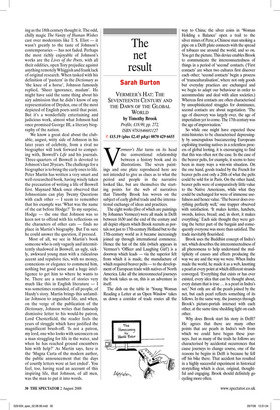The net result
Sarah Burton
VERMEER’S HAT: THE SEVENTEENTH CENTURY AND THE DAWN OF THE GLOBAL WORLD by Timothy Brook Profile, £18.99, pp. 272, ISBN 9781846681127 ✆ £15.19 (plus £2.45 p&p) 0870 429 6655 Vermeer’s Hat turns on its head the conventional relationship between a history book and its illustrations. The seven paintings and one plate reproduced here are not intended to give us clues as to what the period and people in the narrative looked like, but are themselves the starting points for the web of narratives that Timothy Brook has woven on the subject of early global trade and the international exchange of ideas and practices.
The eight works (five of which are paintings by Johannes Vermeer) were all made in Delft between 1630 and the end of the century and all depict objects which Brook recruits as portals not just to 17th-century Holland but to the 17th-century world as it became increasingly joined up through international commerce. Hence the hat of the title (which appears in Vermeer’s ‘Officer and Laughing Girl’) is a doorway which leads — via the superior felt from which it is made, the manufacture of which required beaver pelts — to the development of European trade with natives of North America. Like all the interconnected journeys the book takes us on, this is an adventure in itself.
The dish on the table in ‘Young Woman Reading a Letter at an Open Window’ takes us down a corridor of trade routes all the way to China; the silver coins in ‘Woman Holding a Balance’ open a trail to the silver mines of Peru; a Chinese man smoking a pipe on a Delft plate connects with the spread of tobacco use around the world, and so on. You get the picture. This device enables Brook to communicate the interconnectedness of things in a period of ‘second’ contacts. (‘First contacts’ are when two cultures first discover each other; ‘second contacts’ begin a process of ‘transculturalisation’, where not only goods but everyday practices are exchanged and we begin to adapt our behaviour in order to accommodate and deal with alien societies.) Whereas first contacts are often characterised by unsophisticated struggles for dominance, second contacts are about negotiation. ‘The age of discovery was largely over, the age of imperialism yet to come. The 17th century was the age of improvisation.’ So while one might have expected these mini-histories to be characterised depressingly by unscrupulous buccaneering Europeans exploiting trusting natives in a relentless process of global looting, it is encouraging to find that this was often not the case. In the case of the beaver pelts, for example, it seems to have been in many ways a win-win situation. On the one hand, goods traded by the French for beaver pelts cost only a 20th of what the pelts could be sold for in Paris. On the other hand, beaver pelts were of comparatively little value to the Native Americans, while what they could be exchanged for were of immense usefulness and hence value. ‘The beaver does everything perfectly well,’ one trapper observed with satisfaction. ‘It makes kettles, hatchets, swords, knives, bread; and, in short, it makes everything.’ Each side thought they were getting the better part of the bargain and consequently everyone was more than satisfied. The trade inevitably flourished.
Brook uses the Buddhist concept of Indra’s net, which describes the interconnectedness of all phenomena to help understand the multiplicity of causes and effects producing the way we are and the way we were. When Indra made the world, he made it as a web, knotting a pearl at every point at which different strands converged. ‘Everything that exists or has ever existed, every idea that can be thought about, every datum that is true ... is a pearl in Indra’s net.’ Not only are all the pearls joined by the net, but each pearl reflects something of its fellows. In the same way, the journeys through Brook’s picture-portals intersect with each other, at the same time shedding light on each other.
Why does Brook start his story in Delft? He agrees that there are many other points that are pearls in Indra’s web from which we could have begun these journeys. Just as many of the trails he follows are characterised by accidental occurrences that cause journeys to change course, one of the reasons he begins in Delft is because he fell off his bike there. That accident has resulted in a highly successful experiment in historical storytelling which is clear, original, thoughtful and engaging. Brook should definitely go cycling more often.


























































 Previous page
Previous page